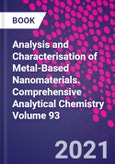Analysis and Characterisation of Metal-Based Nanomaterials, Volume 93 in the Comprehensive Analytical Chemistry series, introduces recent developments in analytical methodologies for detection, characterization and quantification of metal-based nanomaterials and their applications to a variety of complex environmental, biological and food samples as well as different consumer products. Single-particle inductively coupled plasma mass spectrometry is highlighted as a powerful analytical tool for number-based concentration and size distribution, also from the metrological viewpoint. An emerging approach for the measurement of multi-metal nanoparticles by single-particle inductively coupled plasma time-of-flight mass spectrometry is discussed. Imaging of metal-based nanoparticles by hyphenated inductively coupled plasma-based techniques is also introduced. The potential of different liquid chromatography and field flow fractionation separation techniques hyphenated to inductively coupled plasma mass spectrometry is emphasized as a powerful tool in particular for complex matrices and small particles sizes. The use of different microscopic techniques for the characterization of metal-based nanoparticles and characterization of metal-based nanoparticles as contrast agents for magnetic resonance imaging are presented. Moreover, occurrence, behaviour and fate of inorganic nanoparticles in the environment is overviewed. Finally, the need for quality control standards and reference nano-materials is emphasized throughout.
Please Note: This is an On Demand product, delivery may take up to 11 working days after payment has been received.
Table of Contents
1. Occurrence, behaviour and effects of inorganic nanoparticles in the environmentGeert Cornelis and Elma Lahive
2. Single-Particle Inductively Coupled Plasma Mass Spectrometry for the analysis of inorganic engineered nanoparticles: Metrological and quality issues
Francisco Laborda, Ana C. Gimenez-Ingalaturre and Eduardo Bolea
3. Multiplexed and multi-metal Single-Particle characterization with ICP-TOFMS
Alexander Gundlach-Graham
4. Characterisation of inorganic nanomaterials in complex samples by hyphenated Field Flow Fractionation
Heidi Goenaga-Infante, Dorota Bartczak and Isabel Abad Alvaro
5. Hydrodynamic chromatography for the characterization of inorganic nanoparticles
Marco Roman
6. Imaging of metal-based nanoparticles in tissue and cell samples by ICP-based techniques
Heike Traub
7. Microscopic techniques for the characterization of metal-based nanoparticles
Janez Zavasnik, Vasyl Shvalya and Andreja Sestan
8. The use of High Performance Liquid Chromatography
Inductively Coupled Plasma Mass Spectrometry in the analysis of inorganic nanomaterials
Maria Montes-Bayon and Jorg Bettmer
9. Characterization of metal-based nanoparticles as contrast agents for magnetic resonance imaging
Nina Kostevsek and Igor Sersa
10. Detection and characterization of metal-based nanoparticles in environmental, biological and food samples by single particle Single Particle Inductively Coupled Plasma Mass Spectrometry
Janja Vidmar
11. Metal and metal oxide nanoparticles in cosmetics and skin care products
Fabienne Seby








